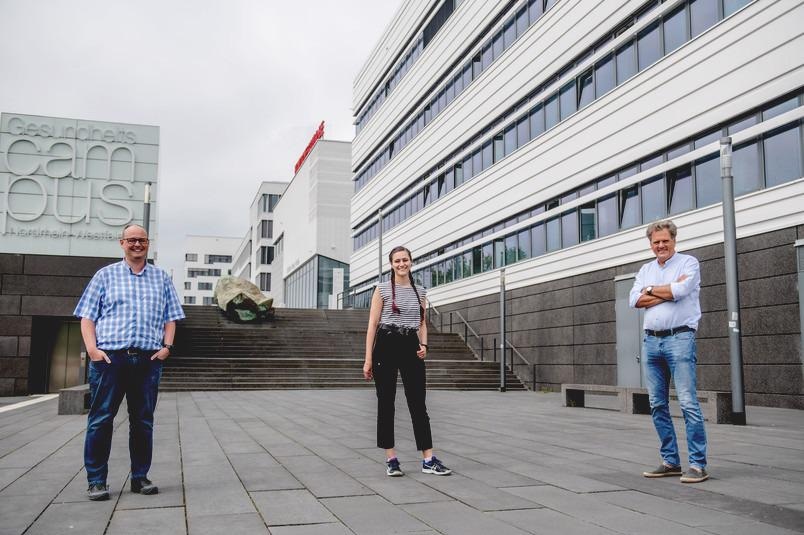Jun 29 2021
The type of lung cancer can vary the prognosis and effective therapies. In the past, it took many days to accurately determine the underlying mutation.
 Frederik Großerüschkamp, Nina Goertzen and Klaus Gerwert (from left) are part of the research team. Image Credit: © Ruhr-Universität Bochum, (RUB), Marquard.
Frederik Großerüschkamp, Nina Goertzen and Klaus Gerwert (from left) are part of the research team. Image Credit: © Ruhr-Universität Bochum, (RUB), Marquard.
A research team from the Centre for Protein Diagnostics (PRODI) at Ruhr-Universität Bochum (RUB) has now reliably determined this mutation in a single step through a combination of artificial intelligence (AI) and quantum cascade laser-based infrared microscopy. This analysis took around 30 minutes and there was no need to mark the examined tissue.
This is a major step that shows that infrared imaging can be a promising methodology in future diagnostic testing and treatment prediction.
Klaus Gerwert, Professor and Director, Centre for Protein Diagnostics, Ruhr-Universität Bochum
The study was published in the American Journal of Pathology on July 1st, 2021.
Treatment Decision by Means of a Genetic Mutation Analysis
There are different kinds of lung tumors, like adenocarcinoma, small cell lung cancer and squamous cell carcinoma. In addition, many sub-types and rare types of tumors also exist. But this diversity hampers rapid and reliable diagnostic techniques in day-to-day clinical practice.
Apart from histological typing, the tumor specimens also need to be thoroughly analyzed for certain changes at the DNA level.
Detecting one of these mutations is important key information that influences both the prognosis and further therapeutic decisions.
Reinhard Büttner, Study Co-Author, Professor, and Head of Institute of General Pathology and Pathological Anatomy, University Hospital Cologne
Lung cancer patients clearly benefit when the driver mutations are characterized beforehand. For example, tumors with activating mutations in the epidermal growth factor gene (EGFR) generally respond well to tyrosine kinase inhibitors, while non-EGFR-mutated tumors or tumors with other kinds of mutations, like KRAS, do not respond to this drug.
Formerly, immunohistochemical staining of tissue samples and a subsequent elaborate genetic analysis were performed to make the differential diagnosis of lung cancer and thus determine the mutation.
Fast and Reliable Measuring Technique
Headed by Klaus Gerwert, the research team has already demonstrated the potential of infrared imaging — or IR imaging for short — as a diagnostic tool to define tissues in previous studies. This method is known as label-free digital pathology. With the help of AI, this procedure automatically identifies cancerous tissues without previous staining or other functions and markings.
While the techniques used in routine clinical practice to determine the shape of tumors and mutations in tumor tissue can sometimes take many days, the new automated process only takes around 30 minutes. Within these 30 minutes, it is possible to ascertain the presence of tumor cells in the tissue sample, the type of tumor and the potential presence of a certain mutation.
Infrared Spectroscopy Makes Genetic Mutations Visible
In this study, the researchers from Bochum successfully validated the procedure on samples collected from more than 200 lung cancer patients. When detecting mutations, they focused on adenocarcinoma, the most common lung tumor to date, which accounts for more than 50% of tumors. The most common genetic mutations of adenocarcinoma can be established with a specificity and sensitivity of 95% when compared to laborious genetic analysis.
For the first time, we were able to identify spectral markers that allow for a spatially resolved distinction between various molecular conditions in lung tumors.
Nina Goertzen, Centre for Protein Diagnostics, Ruhr-Universität Bochum
With a single infrared spectroscopic measurement, detailed information about the sample can be obtained which would otherwise require many laborious procedures.
A Further Step Towards Personalized Medicine
The results further confirmed the potential of label-free digital pathology for clinical use.
Dr. Frederik Großerüschkamp, IR imaging project manager, stated, “To further increase reliability and promote a translation of the method as a new diagnostic tool, studies with larger patient numbers adapted to clinical needs and external testing in everyday clinical practice are required.”
Dr. Großerüschkamp then added, “In order to translate IR imaging into everyday clinical practice, it is crucial to shorten the measuring time, ensure simple and reliable operation of the measuring instruments, and provide answers to questions that are important and helpful both clinically and for the patients.”
Journal Reference:
Goertzen, N., et al. (2021) Quantum cascade laser-based infrared imaging as a label-free and automated approach to determine mutations in lung adenocarcinoma. The American Journal of Pathology. doi.org/10.1016/j.ajpath.2021.04.013.